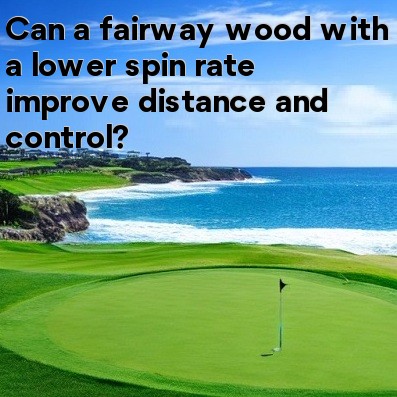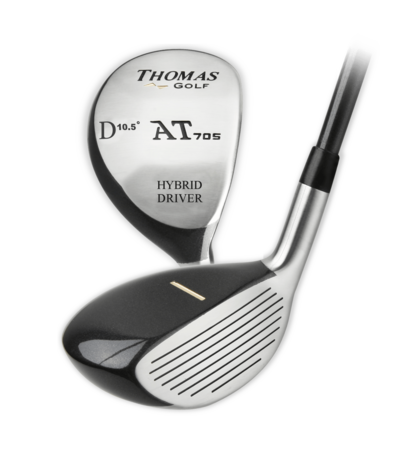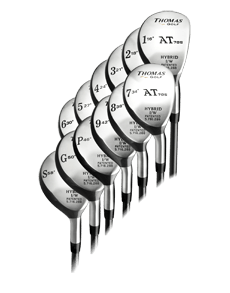

When it comes to selecting the right fairway wood for your golf game, there are several factors to consider. One important factor is the spin rate of the club. A fairway wood with a lower spin rate can indeed improve distance and control for many golfers.
Spin rate refers to the amount of backspin a golf ball has when it is struck with a club. In general, a higher spin rate will cause the ball to fly higher and land with less roll. On the other hand, a lower spin rate will result in a lower trajectory and more roll upon landing.
So how does spin rate affect distance and control? Let's take a closer look.
Distance:
When it comes to maximizing distance, a lower spin rate can be beneficial. The lower trajectory of a shot with less spin can help the ball cut through the air more efficiently, resulting in greater distance off the tee or fairway. With less backspin, the ball experiences less resistance, allowing it to maintain its speed over a longer distance.
In addition, a lower spin rate can also help to reduce side spin. Side spin can cause the ball to curve off course, resulting in a loss of distance and accuracy. By minimizing side spin, shots with a lower spin rate have a better chance of staying on target, resulting in better overall distance.
Control:
While distance is important, control over the golf ball is equally essential. A fairway wood with a lower spin rate can help improve control, especially in windy conditions.
With less backspin, shots are less likely to get caught up in the wind and drift off course. The lower trajectory of shots with low spin can also help to minimize the effect of crosswinds, making it easier to hit the ball straighter and more consistently.
Furthermore, lower spin can enhance control when it comes to shot shaping. When a golfer wants to hit a fade or draw, reducing spin can make it easier to manipulate the flight of the ball. Shots with lower spin rates tend to have a flatter trajectory and more roll, allowing the golfer to shape shots more effectively.
In conclusion, a fairway wood with a lower spin rate can indeed improve both distance and control for golfers. The lower trajectory and reduced side spin can result in greater overall distance, while also providing better control in windy conditions and when shaping shots. When choosing a fairway wood, it's important to consider spin rate along with other factors such as loft, shaft flex, and clubhead design to find the perfect club that suits your game.
Update:
Can a fairway wood with a lower spin rate improve distance and control?
Yes, a fairway wood with a lower spin rate can indeed improve both distance and control. Here's how:
- Increased Distance: Lower spin rates typically result in longer carry distances for fairway wood shots. With less backspin, the ball tends to stay in the air longer, maximizing carry distance and overall yardage. This is particularly beneficial off the tee and on approach shots to longer holes.
- Improved Control: Lower spin rates can also enhance shot control by reducing the amount of side spin on the ball. Shots with lower spin rates tend to fly on a more penetrating trajectory, which can result in straighter ball flights and improved accuracy. This is especially advantageous when navigating tight fairways or avoiding hazards.
- Better Wind Performance: Fairway woods with lower spin rates are less affected by crosswinds and gusts. The reduced spin allows the ball to cut through the air more efficiently, maintaining a more predictable trajectory even in challenging wind conditions. This leads to improved consistency and confidence in shot execution.
- Optimized Landing Angles: Lower spin rates can lead to shallower descent angles for fairway wood shots, resulting in softer landings on the green. This is advantageous on approach shots, as the ball is more likely to stop quickly and hold its position, providing greater control over distance and proximity to the pin.
- Enhanced Versatility: Fairway woods with lower spin rates offer greater versatility in shot selection and shot shaping. Golfers can more easily manipulate ball flight trajectories, enabling them to execute a wider range of shots to suit different course conditions and strategic challenges.
Q&A On Can a fairway wood with a lower spin rate improve distance and control?
- Q: How does spin rate affect distance in fairway wood shots?
- A: Lower spin rates generally result in longer carry distances for fairway wood shots due to reduced air resistance and more efficient energy transfer from the clubface to the ball.
- Q: Can a fairway wood with a lower spin rate help me hit more fairways?
- A: Yes, fairway woods with lower spin rates are typically more forgiving and offer better control, leading to straighter and more accurate shots that find the fairway more consistently.
- Q: What factors contribute to lower spin rates in fairway woods?
- A: Lower spin rates in fairway woods can be achieved through various design features, including clubhead design, weight distribution, and shaft characteristics, as well as proper swing mechanics.
- Q: Are there any drawbacks to using a fairway wood with a lower spin rate?
- A: While lower spin rates offer many benefits, some golfers may find that it requires adjustments in their swing technique or launch conditions to optimize performance. Additionally, extremely low spin rates may lead to difficulties holding the green on approach shots.
- Q: Can I adjust the spin rate of my fairway wood through equipment customization?
- A: Yes, equipment customization such as adjusting loft, shaft selection, and clubhead weighting can influence the spin rate of a fairway wood to some extent, but it's essential to work with a knowledgeable club fitter to achieve optimal results.
- Q: How can I determine the spin rate of my fairway wood shots?
- A: Spin rate can be measured using launch monitors and fitting sessions at golf facilities. These tools provide valuable data on launch conditions, including spin rate, which can help you optimize your equipment and improve your performance on the course.





